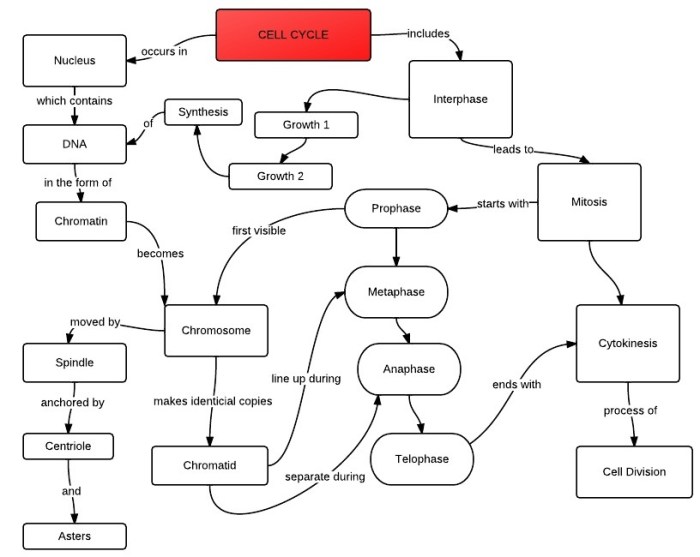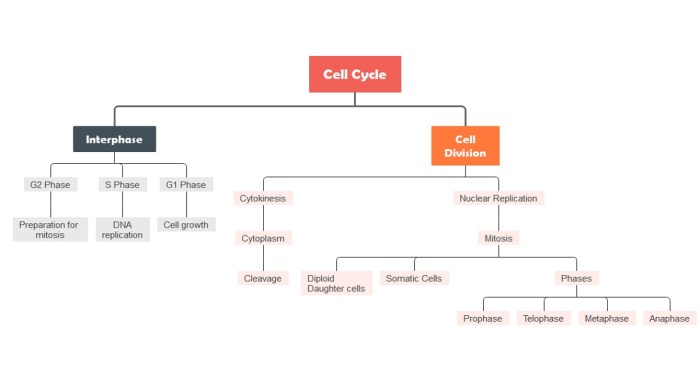Delve into the intricacies of cell division with our comprehensive cell cycle concept map answer key. This invaluable resource provides a visual representation of the cell cycle, guiding you through its phases, regulatory mechanisms, and significance in cell biology.
Prepare to embark on an enlightening journey as we explore the fundamental principles governing cell growth and proliferation, unraveling the mysteries of cellular reproduction.
Cell Cycle Overview: Cell Cycle Concept Map Answer Key
The cell cycle is the ordered sequence of events that a cell undergoes during its lifetime, from one cell division to the next. It consists of two main phases: interphase and the mitotic phase (M phase). Interphase is further divided into three sub-phases: G1 (gap 1), S (synthesis), and G2 (gap 2). The mitotic phase includes prophase, metaphase, anaphase, and telophase, followed by cytokinesis, which divides the cytoplasm and organelles into two daughter cells.
The cell cycle is essential for growth, development, and tissue repair. It ensures the accurate duplication and distribution of genetic material to daughter cells, maintaining genetic stability and preventing uncontrolled cell proliferation.
Phases of the Cell Cycle

Interphase
Interphase is the longest phase of the cell cycle, occupying about 90% of the time. It consists of three sub-phases:
- G1 phase:The cell grows, synthesizes proteins and RNA, and prepares for DNA replication.
- S phase:DNA replication occurs, producing two identical copies of each chromosome.
- G2 phase:The cell checks for DNA damage, repairs errors, and synthesizes proteins necessary for mitosis.
Mitosis
Mitosis is the phase where the cell divides into two daughter cells. It consists of four stages:
- Prophase:Chromosomes condense, the nuclear envelope breaks down, and spindle fibers form.
- Metaphase:Chromosomes align at the metaphase plate, the central plane of the cell.
- Anaphase:Sister chromatids (identical copies of each chromosome) separate and move to opposite poles of the cell.
- Telophase:Two new nuclear envelopes form around the separated chromosomes, the spindle fibers disappear, and cytokinesis begins.
Cytokinesis, Cell cycle concept map answer key
Cytokinesis is the final stage of cell division, where the cytoplasm and organelles are divided into two daughter cells. In animal cells, a cleavage furrow forms, pinching the cell membrane inward. In plant cells, a cell plate forms in the center of the cell, eventually dividing the cytoplasm into two.
Cell Cycle Regulation

The cell cycle is tightly regulated by a complex network of checkpoints and control mechanisms. Key checkpoints occur at the G1/S, S/G2, and G2/M transitions. These checkpoints ensure that the cell has completed the necessary preparations and is ready to proceed to the next phase.
Cyclins and cyclin-dependent kinases (CDKs) are key regulators of the cell cycle. Cyclins are proteins that fluctuate in concentration throughout the cell cycle, activating specific CDKs at different stages. CDKs phosphorylate target proteins, initiating or inhibiting cell cycle events.
External factors, such as growth factors, hormones, and environmental signals, can also influence cell cycle progression. These factors can activate or inhibit specific checkpoints or regulate the expression of cyclins and CDKs.
User Queries
What is the significance of cell cycle regulation?
Cell cycle regulation ensures orderly cell division, preventing uncontrolled cell growth and maintaining tissue homeostasis. Dysregulation can lead to developmental abnormalities and diseases such as cancer.
How does the concept map aid in understanding the cell cycle?
The concept map visually organizes key concepts and relationships, providing a comprehensive overview of the cell cycle. It facilitates understanding of the sequence of events, regulatory mechanisms, and checkpoints involved in cell division.